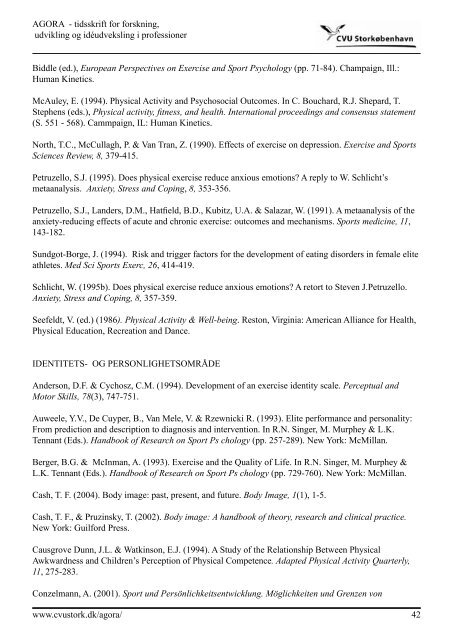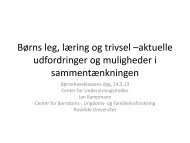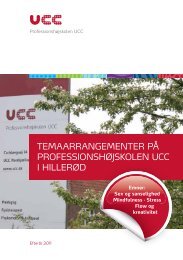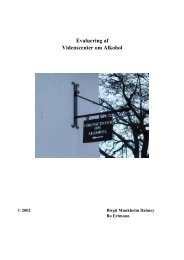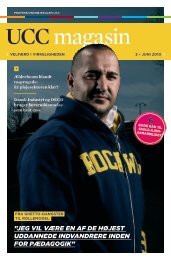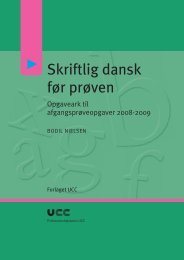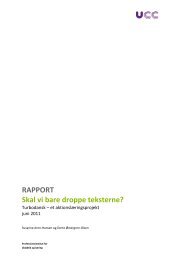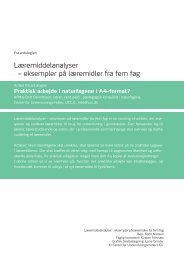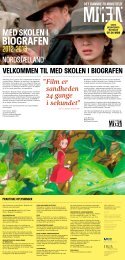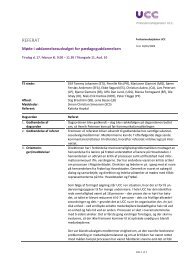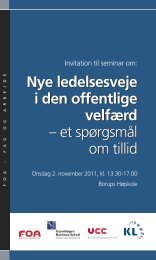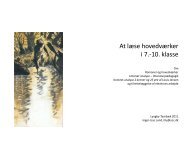AGORA - tidsskrift for forskning, udvikling og idéudveksling i ...
AGORA - tidsskrift for forskning, udvikling og idéudveksling i ...
AGORA - tidsskrift for forskning, udvikling og idéudveksling i ...
You also want an ePaper? Increase the reach of your titles
YUMPU automatically turns print PDFs into web optimized ePapers that Google loves.
<strong>AGORA</strong> - <strong>tidsskrift</strong> <strong>for</strong> <strong>for</strong>skning,<br />
<strong>udvikling</strong> <strong>og</strong> <strong>idéudveksling</strong> i professioner<br />
Biddle (ed.), European Perspectives on Exercise and Sport Psychol<strong>og</strong>y (pp. 71-84). Champaign, Ill.:<br />
Human Kinetics.<br />
McAuley, E. (1994). Physical Activity and Psychosocial Outcomes. In C. Bouchard, R.J. Shepard, T.<br />
Stephens (eds.), Physical activity, fitness, and health. International proceedings and consensus statement<br />
(S. 551 - 568). Cammpaign, IL: Human Kinetics.<br />
North, T.C., McCullagh, P. & Van Tran, Z. (1990). Effects of exercise on depression. Exercise and Sports<br />
Sciences Review, 8, 379-415.<br />
Petruzello, S.J. (1995). Does physical exercise reduce anxious emotions? A reply to W. Schlicht’s<br />
metaanalysis. Anxiety, Stress and Coping, 8, 353-356.<br />
Petruzello, S.J., Landers, D.M., Hatfield, B.D., Kubitz, U.A. & Salazar, W. (1991). A metaanalysis of the<br />
anxiety-reducing effects of acute and chronic exercise: outcomes and mechanisms. Sports medicine, 11,<br />
143-182.<br />
Sundgot-Borge, J. (1994). Risk and trigger factors <strong>for</strong> the development of eating disorders in female elite<br />
athletes. Med Sci Sports Exerc, 26, 414-419.<br />
Schlicht, W. (1995b). Does physical exercise reduce anxious emotions? A retort to Steven J.Petruzello.<br />
Anxiety, Stress and Coping, 8, 357-359.<br />
Seefeldt, V. (ed.) (1986). Physical Activity & Well-being. Reston, Virginia: American Alliance <strong>for</strong> Health,<br />
Physical Education, Recreation and Dance.<br />
IDENTITETS- OG PERSONLIGHETSOMRÅDE<br />
Anderson, D.F. & Cychosz, C.M. (1994). Development of an exercise identity scale. Perceptual and<br />
Motor Skills, 78(3), 747-751.<br />
Auweele, Y.V., De Cuyper, B., Van Mele, V. & Rzewnicki R. (1993). Elite per<strong>for</strong>mance and personality:<br />
From prediction and description to diagnosis and intervention. In R.N. Singer, M. Murphey & L.K.<br />
Tennant (Eds.). Handbook of Research on Sport Ps chol<strong>og</strong>y (pp. 257-289). New York: McMillan.<br />
Berger, B.G. & McInman, A. (1993). Exercise and the Quality of Life. In R.N. Singer, M. Murphey &<br />
L.K. Tennant (Eds.). Handbook of Research on Sport Ps chol<strong>og</strong>y (pp. 729-760). New York: McMillan.<br />
Cash, T. F. (2004). Body image: past, present, and future. Body Image, 1(1), 1-5.<br />
Cash, T. F., & Pruzinsky, T. (2002). Body image: A handbook of theory, research and clinical practice.<br />
New York: Guil<strong>for</strong>d Press.<br />
Causgrove Dunn, J.L. & Watkinson, E.J. (1994). A Study of the Relationship Between Physical<br />
Awkwardness and Children’s Perception of Physical Competence. Adapted Physical Activity Quarterly,<br />
11, 275-283.<br />
Conzelmann, A. (2001). Sport und Persönlichkeitsentwicklung. Möglichkeiten und Grenzen von<br />
www.cvustork.dk/agora/ 42


